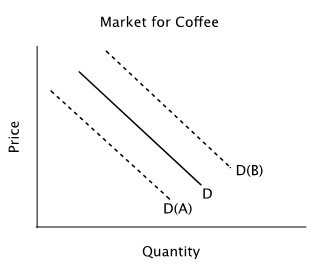Refer to the figure below. Suppose the solid line shows the demand for coffee. If coffee and tea are substitutes, and the price of tea falls, then you would expect: 
A. an increase in the quantity of coffee demanded, but no shift in the demand curve.
B. the demand curve to shift to D(B)
C. the demand curve to shift to D(A).
D. a decrease in the quantity of coffee demanded, but no shift in the demand curve.
Answer: C
You might also like to view...
You and a friend are arguing over the issue of the nonneutrality of money. You believe that money is not neutral, and to prove your point you would cite all of the following except
A) large gold discoveries that increased the money supply preceded an economic boom. B) a change in monetary institutions preceded a boom or recession. C) a change in the leadership of the Fed and its policy was followed by noticeable changes in the money supply and a recession or inflation. D) the fact that every recession was preceded by a drop in the money supply.
The above figure depicts the Edgeworth box for two individuals, Al and Bruce. Points a and b
A) are most likely to reflect the final allocations after trading. B) are least likely to reflect the final allocations after trading. C) are equally likely to reflect the final allocations after trading than other points on the contract curve. D) are definitely not the final allocations after trading.
The external marginal cost of producing coal is MCexternal = 6Q while the internal marginal cost is MCinternal = 4Q. The inverse demand for coal is given by P = 120 ? 2Q. How much output would a monopoly produce?
A. 15 B. 10 C. 20 D. It cannot be determined because of incomplete information.
When a monopolist practices price discrimination, compared to a single-price monopolist, producer surplus will:
A. decrease. B. increase. C. increase initially, and then return to its original level. D. remain the same.